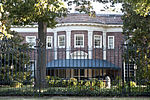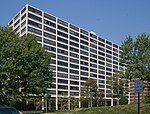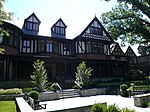Sherwood Gardens
Baltimore geography stubsGardens in MarylandNorthern BaltimoreParks in Baltimore

Sherwood Gardens is a 6-acre (24,000 m2) park located in the Guilford neighborhood of Northern Baltimore, Maryland. The gardens are bordered by East Highfield, Underwood, Stratford and Greenway Roads. In addition to well-groomed, standard ground cover (azaleas, evergreens, etc...), Sherwood Gardens is famous for its nearly 80,000 tulips that peak in late April. After the tulips finish blooming, the Tulip Dig occurs on the Saturday of Memorial Day each year. Anyone can dig up and purchase the tulip bulbs. The park is maintained and managed by Stratford Green, Inc., a 501(c)3 organization.
Excerpt from the Wikipedia article Sherwood Gardens (License: CC BY-SA 3.0, Authors, Images).Sherwood Gardens
Stratford Road, Baltimore
Geographical coordinates (GPS) Address Nearby Places Show on map
Geographical coordinates (GPS)
| Latitude | Longitude |
|---|---|
| N 39.341388888889 ° | E -76.614166666667 ° |
Address
Stratford Road
21218 Baltimore
Maryland, United States
Open on Google Maps









